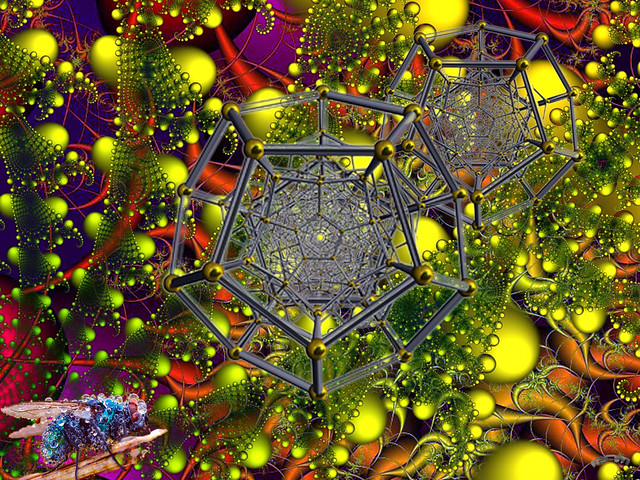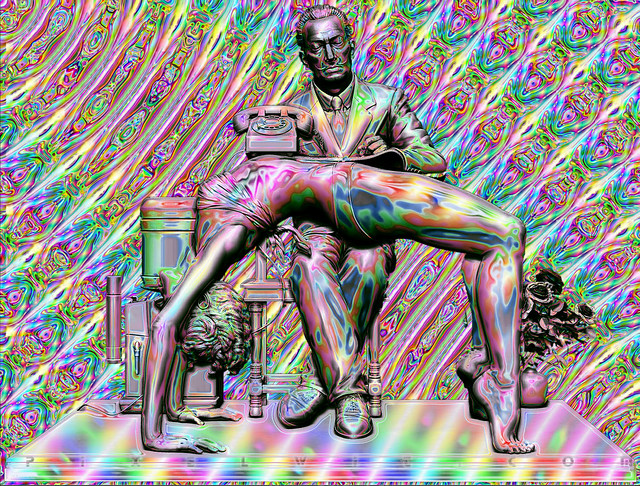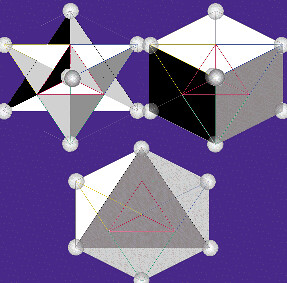The Science Delusion
Steve Marshall talks to Rupert Sheldrake about dogma and delusion in contemporary science
Millions of people around the world claim personal experience of unexplained phenomena, which can be as simple as ‘knowing’ who is calling them when the telephone rings. Mainstream science can provide no explanation for this, other than dismissing it as mere delusion. Rupert Sheldrake, after many years of investigating telepathy, the unexplained powers of animals and human precognition, believes that he can. Sheldrake claims that his theory of ‘morphic resonance’ not only explains these widespread phenomena, it also shows how simple organic forms can self-organise into more complex ones, as an addition to Darwin’s process of Natural Selection. According to Sheldrake:
“The formation of habits depends on a process called morphic resonance. Similar patterns of activity resonate across space and time with subsequent patterns. This hypothesis applies to all self-organising systems, including atoms, molecules, crystals, cells, plants, animals and animal societies.
All draw upon a collective memory and in turn contribute to it. A growing crystal of copper sulphate, for example, is in resonance with countless previous crystals of copper sulphate, and follows the same habits of crystal organisation, the same lattice structure. A growing oak seedling follows the habits of growth and development of previous oaks. When an orb-web spider starts spinning its web, it follows the habits of countless ancestors, resonating across space and time. The more people who learn a new skill, such as snowboarding, the easier will it be for others to learn it because of morphic resonance from previous snowboarders.”
There is far more to morphic resonance than this, but I’m not the one to explain, as I have to admit I don’t understand all of its many aspects. Sheldrake believes that memories are not stored in the brain but somewhere outside of it; the brain recalls them not as a hard drive does, by playing back physically-stored electrical signals, but more like a television that tunes into transmitted signals and decodes them as memories. It does this by morphic resonance. Here, there are strong similarities with Carl Jung’s theory of the collective unconscious and archetypes.
Jung’s ideas were accepted (if rather half-heartedly) by many scientists of his day; although Sheldrake does get support from some of his peers, it tends to come privately. His explorations into the liminal areas of science are particularly unpopular with dogmatic sceptics, who regard the work as ‘pseudoscience’ and “outside the scope of scientific experiment’.
But Sheldrake, to the chagrin of his detractors, is not just another amateur crackpot but a bona fide scientist – a Cambridge-trained biochemist with a double-first-class honours degree and a doctorate. Before developing his current interest in parapsychology, he led more conventional research programmes and made important discoveries in plant physiology. Criticism of Sheldrake’s work makes fascinating reading, as it reveals so much about his critics. There is a good deal of professional jealousy and resentment that Sheldrake’s research continues to be funded by Cambridge University, and sour grapes because he sells a lot of books. Most commonly, his theories and findings are dismissed because they do not conform to accepted scientific dogma; this has made him a particular target of the materialists. Frequent, vitriolic attacks are not directed just at Sheldrake’s work either; in 2008, he was stabbed in the leg by a Japanese madman who had followed him to the USA, believing that Sheldrake was using mind-control techniques on him (FT236:5).
Sheldrake has borne all of this with uncommon grace and good humour; however, he retaliates with his latest book The Science Delusion, an elegant counter-attack on scientific materialism. As attacks go, it is rather polite and gentlemanly, but effective.
Just before publication, I spoke to Sheldrake about the ideas in the book and his motives for writing it. First, the title, which appears to be a direct swipe at Richard Dawkins. Did Dawkins really inspire this response?
“No,” admits Sheldrake, “the title was at the insistence of my publishers, and the book will be re-titled in the USA as Science Set Free. Dawkins is far less important outside Britain. Actually, he’s not really very important here either – it’s just that the British media find him a convenient figurehead for the tide of evangelical atheism we’ve seen in recent years. Dawkins is a passion-ate believer in materialist dogma, but the book is not a response to him – although I do object to his dumbed-down representation of science.
“I’ve actually been thinking about the ideas in this book for many years, perhaps 30 or 40. Certainly, since I was an undergraduate and realised that something had gone horribly wrong with science. There was no point in dealing with the problem piecemeal: it was essential to look at the whole picture. There were so many assumptions in place and I wanted to open things up, which is what I’ve done by turning the issues into questions.”
The Science Delusion begins by laying out the 10 dogmata of modern science:
Everything is essentially mechanical. Dogs, for example, are complex mechanisms, rather than living organisms with goals of their own. Even people are machines, “lumbering robots”, in Richard Dawkins’s vivid phrase, with brains that are like genetically programmed computers.
All matter is unconscious. It has no inner life or subjectivity or point of view. Even human consciousness is an illusion produced by the material activity of brains.
The total amount of matter and energy is always the same (with the exception of the Big Bang, when all the matter and energy of the Universe suddenly appeared).
The laws of nature are fixed. They are the same today as they were at the beginning, and they will stay the same forever.
Nature is purposeless, and evolution has no goal or direction.
All biological inheritance is material, carried in the genetic material, DNA, and in other material structures.
Minds are inside heads and are nothing but the activities of brains. When you look at a tree, the image of the tree you are seeing is not ‘out there’, where it seems to be, but inside your brain.
Memories are stored as material traces in brains and are wiped out at death.
Unexplained phenomena like telepathy are illusory.
Mechanistic medicine is the only kind that really works.
Each of these is allotted a chapter in the form of a question, and a short list of further related questions addressed directly to materialists. Some are very funny, highlighting the inherent and often silly contradictions in so much accepted dogma. Is Nature Mechanical?, for example, points out that the mechanistic theory was intended to be a metaphor but has come to be taken literally. Living organisms are not automata, a fact that is patently obvious to any cat or dog owner; few readers would regard themselves as a genetically programmed machine in a mechanical Universe. As Sheldrake puts it: “Most of us feel we are truly alive in a living world – at least at weekends.” Two of his questions to materialists are: “Do you think that you yourself are nothing but a complex machine?” and “Have you been programmed to believe in materialism?”
Sheldrake questions many of science’s basic ‘truths’, which are revealed, with splendid irony, to be either assumptions or, heaven forbid, beliefs. That the Universe began with a Big Bang has been orthodoxy since the 1960s, but it is actually a theory, and one that raises as many questions as it provides answers. Sheldrake does not dispute the theory but compares it to religious creation myths, all of which begin with an initial act of creation by God; the Big Bang theory is different only in that God has been removed from the story. One of the basic tenets of physics is the law of conservation of matter and energy, which asserts that neither can be created or destroyed: the amount of matter and energy in the Universe is always the same. Except of course, in the primal singularity of the Big Bang, when the Universe appeared from nothing, violating all of science’s laws. Sheldrake quotes Terence McKenna: “It’s almost as if science said, ‘Give me one free miracle, and from there the entire thing will proceed with a seamless, causal explanation.’”
Most physicists believe that only about four per cent of the mass and energy in the Universe is conventional; the remaining 96 per cent is made up of ‘dark matter’ and ‘dark energy’, about which nothing is known. Gravitation should be slowing down the expansion of the Universe, but observations made in the mid-1990s showed that it is actually speeding up. The continued expansion of the Universe is now believed to be driven by dark energy, which is reckoned to account for 73 per cent of the Universe’s total mass-energy.
In the current model, the amount of dark energy may be increasing, counteracting the gravitational pull that should make the Universe contract, driving its expansion in an apparently continuous process of creation. This should not be possible, but the conservation laws apply only to the four per cent of ‘standard’ matter and energy, not necessarily to the mysterious remaining 96 per cent. In the light of modern cosmology, asks Sheldrake, how can anyone possibly be sure that the total amount of matter and energy has always been the same?
The reliability of another of science’s ‘constants’ is also doubtful: the speed of light may not be as constant as we have been led to believe. “When I investigated this some years ago,” Sheldrake tells me, “I came to realise that although the speed of light is assumed to be constant and precisely known, there is evidence to suggest otherwise. The speed of light is measured regularly, in university laboratories all around the world, and each comes up with slightly different results. The final figure is arrived at by a committee of expert metrologists who average the ‘best’ results and arrive at a consensus. But this is not based on all the results they are supplied with; some are discarded, either because they differ too much from what is expected or because their source is not considered totally reliable.”
Measurement of the speed of light began in the early 20th century. Initially, there were considerable variations, but by 1927 the experts had agreed on an “entirely satisfactory” speed of 299,796km (186,300 miles) per second. The following year, this mysteriously dropped by around 20km (12 miles) per second. The new speed was recorded all around the world, with the ‘best’ values closely matching. This lower speed remained constant from about 1928 to 1945, then in the late 1940s it went back up again. It was suggested by some scientists that this might indicate cyclical variations in the speed of light.
“Now we may never know,” Sheldrake laments, “because the problem was eventually solved by locking the speed of light into a closed loop. The metre is now defined by the speed of light – which is defined in metres. So if the speed of light really does vary in the future, the metre will vary with it, and we shall have no way of telling! I took this up,” he goes on, “with some of the experts. I visited one – he actually had a sign on his door saying Chief Metrologist. When I inquired about the 1928 to 1945 variation he muttered, ‘Oh you know about that, do you?’ He admitted it was a little embarrassing that so many respected scientists had made faulty measurements during that period…
“‘But this is interesting!’ I said. ‘What if there really were variations? Shouldn’t it be investigated?’ He looked at me aghast. ‘Whatever for? The speed of light is a constant!’ The Universal Gravitational Constant also varies,” adds Sheldrake, “but they’re a bit more open about that.”
The constancy of the speed of light is regarded as sacrosanct among physicists. When alleged ‘faster than light’ neutrinos made world news last summer, the celebrated Professor Brian Cox explained the issue in layman’s terms for BBC radio. Adamant that the speed of light is a “universal speed limit” that can never be exceeded, he came up with a neat analogy. If an aeroplane were to travel from London to Australia at this absolute maximum speed, there would be no way of making the journey any faster. Apart from, he added, digging a tunnel through the Earth and taking a shortcut. So you see, declared Cox cheerfully, the neutrinos are not necessarily travelling any faster than light – they may be simply taking a shortcut through another dimension! To a non-physicist, it seems surprising that experts find it easier to accept a universe of multiple dimensions (which is possible, but only theoretical) than to question scientific dogma.
Are memories stored as material traces in the brain? Sheldrake is not alone in concluding that they are not. Since the 1890s, a vast amount of research time and money has been spent on this fascinating question and still no traces have been found. Typically, laboratory animals are taught to perform some task, then parts of their brains are surgically removed; later, they can still remember what they have been taught, despite in some cases having hardly any brain left at all. The animals presumably also learn to distrust humans wearing white coats.
Sheldrake explores the evidence in great detail and puts a very convincing case. One of his arguments against physically-stored memory is that: “Memories can persist for decades, yet the nervous system is dynamic, continually changing, and so are the molecules within it.” So how could memory be stored in the brain so that it is not lost by molecular turnover? Sheldrake cites recent experiments in which cater-pillars were taught to avoid a stimulus. After undergoing two larval moults and metamorphosis within the pupæ, the resultant moths still remembered what they had learned as caterpillars.
Sheldrake maintains that memories are stored somewhere outside of the brain and retrieved by morphic resonance. So could these memories – and perhaps ideas – be accessed by others? I once met the late Bob Moog at a Theremin convention and thanked the Great Man for inventing voltage-controlled synthesisers. To my surprise, he looked slightly embarrassed and shrugged: “Oh, it was no big deal, just an idea that was going around at that time – it was in the air. Lots of other people must have had the same idea, but I was just lucky that I was able to do something with it.” Most creative people have experienced the zeitgeist at some time or other; had Sheldrake, I inquired, ever known any materialist scientists to complain of falling victim to it?
“No,” he laughs. “But I’m probably the last person they’d tell about it anyway! It has happened many times in science though: Newton and Leibniz, for instance, both simultaneously invented Calculus. On the 75th anniversary of Vogue magazine, I was invited to a symposium at Vogue House to talk on morphic resonance and the zeitgeist. There were many people from the fashion world designers, retailers and so on, and some from finance and the stock market. All were convinced there is a zeitgeist and that they had experienced it. Some had suspected they had spies working inside their company, passing ideas onto their rivals! But it’s people accessing a collective memory. I haven’t dealt with creativity at all in this book, but I believe creative people may be tapping into something beyond space and time.
“When I was writing A New Science of Life, I was very aware that others must be working on the same idea, so I’d better get on with it. And sure enough, there were two or three. One of them, Nicholas Greaves, was not a scientist but an estate agent; he just had this idea come into his head and felt he must express it. His version is called ‘Duplication Theory’. We met, and found that both of us had ideas that were very similar.”
In The Science Delusion, Sheldrake reminds us that scientists are, above all else, human, with all the short-comings and foibles of other mere mortals: “They compete for funding and prestige, constrained by peer-group pressures and hemmed in by prejudices and taboos.” This image runs directly counter to that actively promoted by scientists in recent history – one of a totally impartial, dispassionate elite, who can be uniquely relied upon to reveal the exact truth. Sheldrake quotes Ricky Gervais, who naïvely claims that: “Science is humble… It doesn’t get offended when new facts come along.” This popular view of science is aired regularly in the media by other high-profile celebrities. Stephen Fry (“The stupid person’s clever person”) is an enthusiastic devotee of Richard Dawkins, whose supporters, incidentally, include a surprising number of comedians.
Since the Enlightenment of the 18th century, the world of science has professed to operate in “an open-minded spirit of enquiry” but this is rarely true in practice; any modern research programme is under a good deal of pressure to not produce unexpected or unwanted results. Making waves by questioning accepted dogma is simply not on. Rupert Sheldrake may well be correct in his assertion that something fundamental has been ignored by science – it could even be something as important as gravity. But unless science comes to practise the open-mindedness that it preaches, we may never know. As Sheldrake writes:
“In the Enlightenment ideal, science was a path to knowledge that would transform humanity for the better. Science and reason were the vanguard. These were, and still are, wonderful ideals, and they have inspired scientists for generations. They inspire me. I am all in favour of science and reason if they are scient-ific and reasonable. But I am against granting scientists and the materialist worldview an exemption from critical thinking and sceptical investigation. We need an enlightenment of the Enlightenment.”
By Steve Marshall
Rupert Sheldrake website: www.sheldrake.org
Nicholas Greaves website: www.mindandmemory.net
From The Fortean Times @ http://www.forteantimes.com/features/fbi/6421/the_science_delusion.html
For more information by and about Rupert Sheldrake see http://nexusilluminati.blogspot.com/search/label/rupert%20sheldrake
Help This Unique Independent Site Survive
Donate any amount and receive at least one New Illuminati eBook!
Just press the button -
Xtra Images – R. ayana @ http://farm6.staticflickr.com/5069/5618703444_473d491889_b.jpg
http://farm7.staticflickr.com/6155/6161617018_4750c0ff5c_b.jpg
http://farm7.staticflickr.com/6064/6161617002_e105a61d7f_b.jpg
http://farm7.staticflickr.com/6155/6161617018_4750c0ff5c_b.jpg
http://farm7.staticflickr.com/6064/6161617002_e105a61d7f_b.jpg
For further enlightening information enter a word or phrase into the search box @ New Illuminati or click on any label/tag at the bottom of the page @ http://nexusilluminati.blogspot.com
And see
New Illuminati – http://nexusilluminati.blogspot.com
New Illuminati on Facebook - https://www.facebook.com/the.new.illuminati
New Illuminati Youtube Channel - http://www.youtube.com/user/newilluminati/feed
The Her(m)etic Hermit - http://hermetic.blog.com
The Prince of Centraxis - http://centraxis.blogspot.com (Be Aware! This link leads to implicate & xplicit concepts & images!)
This site is published under Creative Commons Fair Use Copyright (unless an individual item is declared otherwise by copyright holder) – reproduction for non-profit use is permitted & encouraged, if you give attribution to the work & author - and please include a (preferably active) link to the original along with this notice. Feel free to make non-commercial hard (printed) or software copies or mirror sites - you never know how long something will stay glued to the web – but remember attribution! If you like what you see, please send a small but heartfelt donation or leave a comment – and thanks for reading this far…
Live long and prosper!
From the New Illuminati – http://nexusilluminati.blogspot.com







